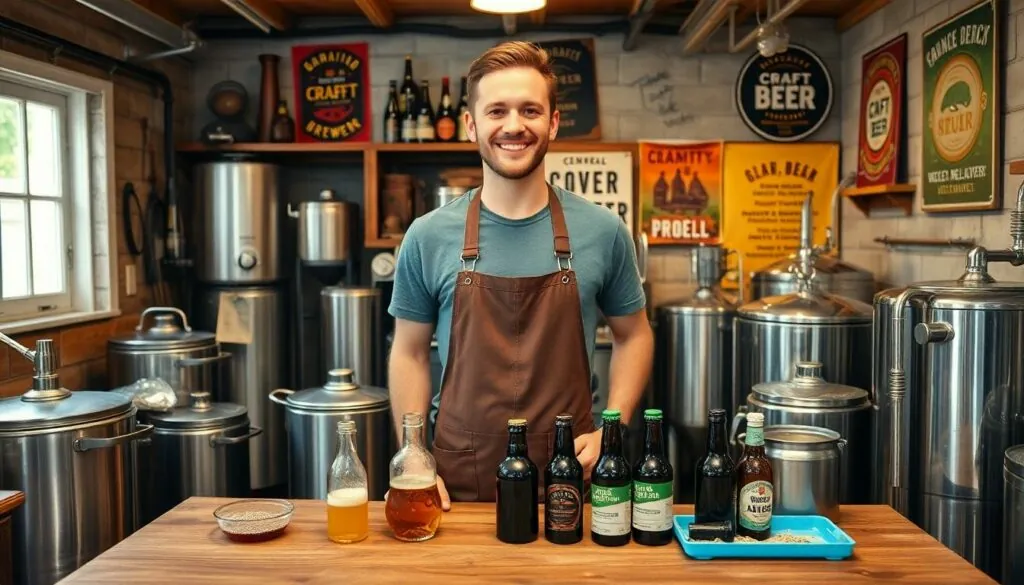In a world where the 9-to-5 grind often feels like a never-ending sitcom, many are turning to side hustles for a little extra cash—and a whole lot of fun. Enter the side hustle brewery, where brewing dreams brew up alongside those ambitious ambitions. Why settle for a boring desk job when you could be crafting artisanal ales that could make even the most discerning beer snob raise an eyebrow?
Table of Contents
ToggleOverview of Side Hustle Breweries
Side hustle breweries represent a burgeoning trend among aspiring entrepreneurs passionate about craft beer. Individuals combine brewing skills with the desire to create unique flavors. Many seek additional income through this creative outlet, as they explore various beer styles, from IPAs to stouts.
Market research indicates that the craft beer industry continues to expand, with over 8,000 breweries operating in the United States as of 2023. This growth creates opportunities for side hustle breweries to thrive alongside established brands. Investors increasingly look towards small-scale, artisanal producers to meet consumer demand for locally sourced products.
Starting a side hustle brewery involves several critical steps. First, aspiring brewers must research local laws and regulations regarding homebrewing and selling alcohol. Understanding licensing requirements can prevent potential setbacks. Next, individuals should experiment with recipes and refine their brewing techniques to produce high-quality beer consistently.
Building a customer base is essential for success. Engaging with local communities through farmers markets, festivals, and social media platforms can generate interest. Additionally, offering educational tasting events can create loyal customers who appreciate craft brewing.
The costs associated with launching a side hustle brewery can vary, depending on equipment and ingredients. Basic brewing equipment can range from $100 to $1,000, while more advanced setups may exceed $5,000. Despite these initial expenses, many find the investment rewarding due to the personal satisfaction and community engagement brewing fosters.
Side hustle breweries enable individuals to turn passion into profit, offering a blend of creativity and entrepreneurship. As the craft beer culture continues to evolve, these small-scale operations play a vital role in shaping the future of the beverage industry.
Benefits of Starting a Side Hustle Brewery

Starting a side hustle brewery offers numerous advantages that can enhance both personal and financial well-being.
Financial Freedom
A side hustle brewery provides financial opportunities that traditional jobs might not. Owners can set their prices and manage expenses based on their brewing capacity. Potential earnings can range from a few hundred dollars to several thousand each month, depending on sales volume and market demand. Craft beer enthusiasts often pay premium prices for unique brews, increasing profitability. Moreover, revenue from this entrepreneurial venture can contribute to debt repayments or savings goals. With time, the brewery may provide significant supplementary income, paving the way for financial independence.
Creative Expression
Creative expression thrives within the realm of brewing. Aspiring brewers can explore diverse styles, such as IPAs or stouts, allowing them to experiment with flavors and techniques. Each batch presents an opportunity to innovate and develop signature brews that showcase personal taste. Engaging with local ingredients fosters a connection to the community, enriching the brewing experience. Sharing these creations with customers not only builds brand loyalty but also creates a platform for storytelling. Passionate homebrewers often turn their hobbies into art, enhancing their satisfaction and fueling their entrepreneurial spirit.
Challenges Faced by Side Hustle Brewers
Side hustle brewers face several challenges that can impact their journey toward success.
Regulatory Hurdles
Navigating the regulatory landscape presents significant obstacles for aspiring brewers. Each state has its own laws governing the brewing process, distribution, and sales. Licensing requirements can vary widely, leading to potential delays and confusion. In 2023, understanding local ordinances remains crucial to avoid penalties, with some jurisdictions imposing strict restrictions. Many brewers spend weeks or months ensuring compliance, which diverts time from actual brewing. Establishing connections with local brewery associations often helps clarify requirements, easing the pathway to compliance.
Time Management
Balancing a full-time job with brewing demands careful time management. Crafting quality beer requires hours dedicated to brewing, fermentation, and bottling. Many side hustle brewers face challenges in allocating sufficient time for each phase of production. Weekends often become prime brewing periods, while weekday evenings may involve marketing or meeting customers. Prioritizing tasks efficiently can dramatically influence output quality and business growth. Crafting a structured schedule that includes specific brewing sessions and marketing efforts often proves essential to maintaining momentum.
Success Stories of Side Hustle Breweries
Numerous side hustle breweries have emerged as success stories, transforming passions into profitable ventures. One notable example is the case of a couple who started brewing at home and gained local popularity. They quickly expanded their operations after launching a small batch of unique IPAs. This couple now operates a successful brewery, earning significant monthly revenue and cultivating a loyal customer base.
Another story features a former corporate professional who turned their love for stouts into a thriving side gig. With initial investments totaling $3,000, this entrepreneur focused on creative flavors, captivating the local craft beer scene. Busy at farmers markets and community events, they shared their brews and connected with beer enthusiasts, significantly increasing their brand’s visibility.
Individuals have also found success through social media marketing. By sharing their brewing journey online, enthusiasts attracted followers and potential customers. They capitalized on this engagement by launching limited edition brews, leading to increased sales and even national recognition.
One brewer overcame regulatory hurdles by seeking mentorship from established industry veterans. This guidance proved invaluable, helping her navigate local laws and streamline her operations. Such mentorship highlights the importance of community support in the side hustle brewing journey.
Creativity remains a common thread among successful side hustle breweries. Many brewers prioritize experimenting with flavors, leading to unique creations that resonate with customers. These distinct selections often set them apart from competitors and contribute to their brand identity.
Fulfilling dreams through brewing can foster community ties. Success stories demonstrate that side hustle breweries not only generate income but also enhance local culture. Passionate brewers are reshaping their neighborhoods, encouraging others to follow in their footsteps.
Tips for Aspiring Side Hustle Brewers
Research local regulations thoroughly. Each state has distinct laws governing brewing, distribution, and sales, creating potential legal challenges. Understanding these rules helps avoid penalties and ensures compliance.
Focus on equipment costs versus quality. Initial investments can range from $100 to over $5,000, depending on desired equipment and ingredients. Selecting high-quality tools enhances brewing success, making the investment worthwhile.
Engage with the community consistently. Participating in farmers markets and hosting educational events builds a loyal customer base. Establishing connections with local enthusiasts fosters brand loyalty and expands market reach.
Experiment with diverse beer styles. Creativity plays a crucial role in standing out in the competitive craft beer industry. Whether brewing IPAs or stouts, unique flavors can attract a broader audience and create buzz.
Schedule dedicated brewing time. Balancing a full-time job with brewing demands effective time management. Craft quality beer by prioritizing tasks, ensuring sufficient time for brewing, fermentation, and bottling.
Utilize social media for promotion. Effective marketing strategies help reach potential customers. Showcasing brewing stories and unique recipes online creates engagement and interest in products.
Seek mentorship from established brewers. Gaining insights from experienced professionals can simplify the path to success. Learning about best practices and overcoming common hurdles enhances confidence and skill.
Share success stories to inspire. Highlighting local brewers who’ve thrived serves as motivation for newcomers. Their experiences reflect the potential of turning passion into profit while enriching community culture.
Starting a side hustle brewery offers a unique blend of creativity and financial opportunity. As the craft beer scene continues to flourish, aspiring brewers can carve out their niche by experimenting with flavors and styles. Engaging with the community not only builds a loyal customer base but also fosters a sense of belonging.
While challenges like regulatory compliance and time management exist, the rewards often outweigh the difficulties. The journey of transforming a passion for brewing into a successful venture can be deeply fulfilling. With dedication and the right resources, anyone can turn their brewing dreams into reality, contributing to the vibrant culture of craft beer.





